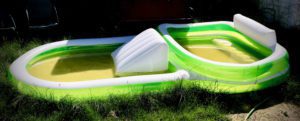DO YOU KNOW WHAT “BABY” MOSQUITOES LOOK LIKE?
By Chris Williams on July 15, 2019.
Everyone knows what a mosquito looks like (although we still confuse them with harmless midges). Once you’ve endured mosquitoes biting you, you tend to remember the enemy. But not everyone knows what the immature stages of mosquitoes look like. That’s important because, while the elusive adult mosquito flies around and can’t always be caught or killed, the larval stage is probably developing right under your nose…and you can do something about it!
MOSQUITO LARVAE CAN DEVELOP IN YOUR YARD
Mosquito larvae and pupae look totally different from adult mosquitoes. The larvae are rather worm-like without wings and without the biting mouthparts of the adult mosquito. The biggest difference though is that mosquito larvae are aquatic. They hatch from eggs in water and feed and develop in the water for about a week before they go through a brief pupal stage and then emerge from the water as flying adult mosquitoes.
The reason that you can find mosquito larvae growing up in your own yard is that they develop in shallow, still, stagnant water that contains a bit of organic debris for them to feed on. Some species prefer to lay their eggs in artificial or man-made containers that will hold water such as buckets, cans, plant saucers, old tires, even wheelbarrows and kiddie pools. Plastic tarps over boats or woodpiles can hold enough water in their folds or dips for mosquitoes to develop. Other mosquitoes lay eggs in tree holes or in moist puddles or soil depressions that are due to be flooded during rain.

Stagnant pool in a yard breeding mosquitos. Z. Ciras
LOOK FOR MOSQUITO “WIGGLERS” IN STANDING WATER
Fully-grown mosquito larvae are about ¼-inch long and can be seen hanging from the surface of the water, if you move carefully. Most species hang upside down using an air tube near the tip of their abdomen that makes contact with the surface and allows them to breathe. While hanging from the surface, they feed on tiny organisms and debris using filtering hairs around their mouths. But, at the least disturbance, the larvae (also called “wigglers”) jerk down to the bottom to escape predators, slowly floating back to the surface when the coast is clear.
Mosquito pupae are also aquatic but look more like curled-up mosquito larvae. They also breathe at the surface. Unlike other insect pupae though, mosquito pupae are active. They’re called ”tumblers” because they will head for the bottom using a rolling dive. If you see lots of pupae in your standing water, you are only a day or two away from having biting mosquitoes instead.
SIMPLE PEST CONTROL — DRAIN THE WATER!
The good thing about all this knowledge is that you can do some basic mosquito control on your own. You can eliminate many developing mosquitoes by simply dumping out or draining the water that the larvae are living in. Easy. No standing water, no mosquitoes.
Canvassing your yard for developing mosquito larvae can serve many purposes. It’s an entertaining competition for the kids once they know what to look for. You will probably discover lost buckets and other items around your property that you didn’t even know you had. You might notice areas of poor drainage where water always stands or you might discover that your roof gutters are so clogged that there is always some water there, too. If the buckets you find are dry, you still need to turn them over or store them under cover because it’s almost certain to rain again some day.
Here are some tips on where to look for developing mosquito larvae: